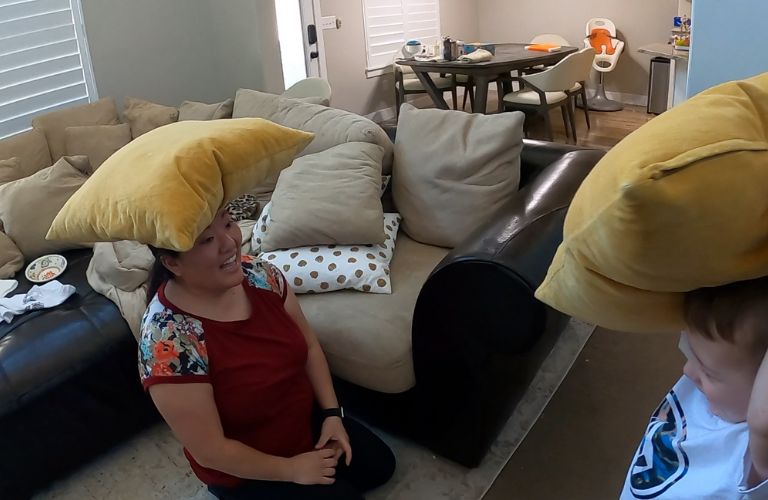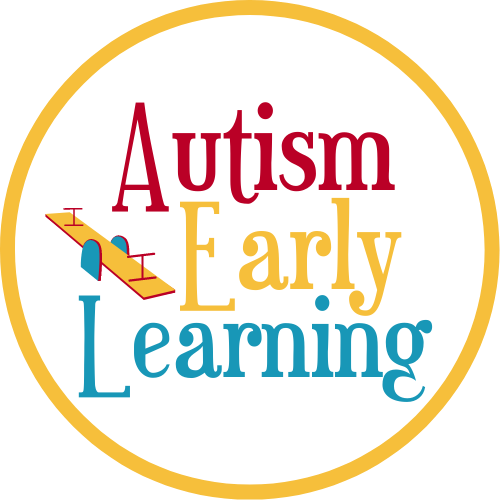Before I talk about ways to help an autistic child increase communication skills, I want to talk about the purpose of communication.
Communication is how we share ideas, thoughts, and feelings. It’s also one of the ways that we build relationships with others. We can communicate through words, but oftentimes when you’re working with a child that does not talk yet, it will come through different avenues. It can come through gestures, facial expressions, sounds, pictures, signs, or an augmentative and alternative communication (AAC) device.
When I start working with a new family, one of the things I always do is have the parents play with their child while I observe. This gives me a baseline of the child’s play skills as well as the parent’s play skills.
As adults, there are some things we do a lot without realizing what we’re doing. The 3 tips I have for you today are 3 things to avoid doing. And by not doing these three things, your child will have more motivation to communicate with you.
Stop Reading Your Child's Mind
When a child has limited communication skills, it’s natural for a parent to want to help their child as much as possible. One of the ways that we tend to do this is we predict what our kids want before they tell us what they want.
Here’s a simple example. Andy’s mom sees that Andy’s cup is empty, so she picks it up and fills it up with milk. Then she sets it down in front of him. Andy’s mom sees a need, and she fulfills it, that’s what parents do. The problem with this is that Andy was just forfeited the opportunity to request more when he wanted more. He didn’t have to interact or communicate his needs because they were already fulfilled.
When a child is in the beginning stages of learning to communicate, they are oftentimes motivated by their wants and needs. If we read their minds and predict their wants and needs too often, we take away the motivation for them to communicate with us.
Instead of immediately getting what you think your child needs or wants, wait. Don’t rush it, don’t prompt, just wait. Even if your child gets upset because he wants milk and doesn’t ask for more, he’s still communicating.
So, let’s go over that same example. Andy’s cup is empty, his mom knows that he will want more, but she doesn’t get him more yet because he hasn’t indicated that he wants more. A few minutes go by, and Andy tries to drink his milk, but it’s all gone. Andy pushes his cup towards his mom (this is communication). Mom says takes the cup and says “more milk?” and Andy makes a whining sound. Mom says “more milk” and gets him more milk. After she fills it up, she hands it back to Andy and says “more milk.”
Andy communicated by pushing his cup towards his mom, and then making a whining sound. Mom was able to model “more milk” 3 times during their interaction. As Andy is able to open and close more circles of communication, his mom will be able to facilitate more opportunities for communication.
Stop Asking So Many Questions During Play Time
Yes, asking and answering questions is a form of communication. However, if you are constantly asking questions, you are monopolizing the conversation and your child won’t have the opportunity to come up with her own ideas and communicate them to you.
Adults like to ask kids questions all the time, even if the kid doesn’t talk back.
- What color is this?
- What shape is this?
- What sound does the B make?
- How many are there?
- Where’s the cat?
Play Time is a time for kids to be creative, to problem solve, and to share their ideas with others. Even if a child is not talking verbally, if you watch them play you will see their ideas. Their ideas may be completely different than yours, and that’s great. When we follow the child’s lead, we get insight into their ideas, we learn how to increase engagement, and we can find ways to build communication.
Instead of asking questions, you can make comments.
- Instead of saying “what color is that?” you can say “I love your orange car! It’s so fast!”
- Instead of saying “what shape is this?” you can say “I’m going to put my car in the circle”
- Instead of saying “how many are there?” you can say “You put 10 cars down the slide, that was fun!”
You’re modeling language while finding out what your child’s ideas are. Narrating what’s happening is a great way to get a little more engagement. Sharing ideas (communicating) can be as simple as taking turns doing different things with your cars. Your child puts a car down the slide, you make your car go up the slide. Your child drives the car in a circle, you make your car fly. You’re exchanging ideas through your actions. It’s fun and it’s motivating.
Stop Giving So Many Directions When You're Playing
One challenge that I give to families the first time I meet with them is to have play sessions where they don’t ask any questions and don’t give any directions. It’s harder than you would think, and it takes some practice. Film yourself doing it, and then watch it back and see if you catch yourself asking questions or giving directions.
When you’re following your child’s lead, that means you’re not always telling them what to do. We want kids to learn to problem solve and to think on their own, we don’t want them to become prompt dependent waiting for you to tell them what to do. Extra wait time isn’t a bad thing, just wait a little longer than you’re used to before giving any directions.
You can model different things, and if your child sees you doing something and they start doing it without you telling them to do it, then it’s now their idea. Kids learn through imitation, but they don’t always have to be told to imitate. Sometimes you’ll want to imitate them as well.
Try to get as many back and forth interactions without all the questions and directions. It’s might be a challenge, but it’s a good challenge.
These are just 3 simple ways to help your child increase communication. There’s a lot more out there, but if you don’t know where to start, then start here. Take time to play with your child and provide opportunities of engagement and back and forth interactions. Have fun!
5 Things You Can Do When You Can't Get Your Child To Engage In Play
Enter your name and e-mail to receive your 5 Tips To Improve Engagement along with more strategies and techniques to help you increase learning and growth.




